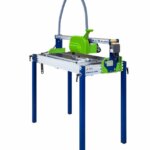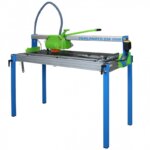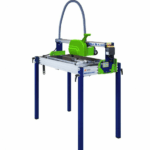Many tile cutting saws on the market today are classified as bridge tile saws, but for someone without much experience in construction or home improvement, it might not be entirely clear what a bridge tile saw even is. So, in this post, we’ll go over what this term means and offer some examples of bridge tile saws produced exclusively by SIMA, as well as some tips for using this type of machine.
Putting the ‘bridge’ in bridge tile saw
The phrase ‘tile saw’ is fairly self-explanatory—a power saw used to cut through tile (and similar materials). But what does the word ‘bridge’ mean in this context?
Basically, bridge saw refers to the shape or structure of the machine. Some bridge saws are small and used to cut things like tile, while others are very large and capable of cutting through huge slabs of stone. But no matter their size, all bridge saws have the same essential structure, with a bridge of sorts spanning two supports, one on each side of the machine, along which the saw’s cutting head slides during operation. The bridge, then, is simply the track from which the cutting head hangs, and the saw operator pushes it back and forth along the bridge to drive the blade into the tile and cut it.
This is an alternative to other types of tile saws and masonry saws, such as those with a fixed cutting head and a sliding table, or a mobile cutting head that does not move along a bridge-like guide.
For example, there is the SIMA Perlanato bridge tile saw, available for blade diameters of 10” and 8”. Another model is the SIMA Ambar bridge tile saw. In both cases, you can see the bridge-like shape of the machine.
How to use a bridge tile saw
Using a bridge tile saw isn’t very different from operating any other type of wet tile saw or masonry saw. First, it is always a good idea to do a quick safety check, inspecting visible belts, cords, bolts, etc. If your particular model has an incorporated water tank, fill it with water and confirm that the water pump works perfectly before trying to cut anything. If the tile saw has water hookups instead, they need to be attached to a hose and an external water source.
Dry cutting tile with a bridge tile saw is not recommended in the vast majority of cases. However, if you have to dry cut, you need to take some additional preparatory steps. You will have to buy a diamond blade designed for dry cutting, and you must wear a respirator mask to protect yourself from serious and irreversible lung damage. Finally, keep in mind that your cutting technique will be slightly different because you will have to stop frequently to allow the blade to cool down.
Once everything on your bridge tile saw is ready and checked for safety, and your tiles are marked, place the tile on the saw’s cutting table so that your mark is aligned with the blade, and clamp the tile down to hold it firm during cutting. Now, turn on the water pump, power on the tile saw, and slowly push the cutting head along the bridge so that the blade makes contact with the tile. Keep applying even, gentle pressure until the blade has passed all the way through the other end of the tile.





